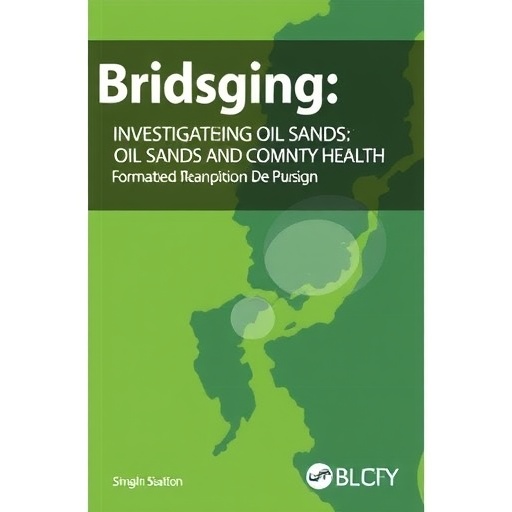In the vast expanse of Alberta’s oil sands, an environmental and public health crisis quietly unfolds, demanding urgent and rigorous scientific attention. The sprawling tailings ponds—reservoirs filled with toxic byproducts of oil extraction—have grown to an alarming scale, now reportedly twice the size of the city of Vancouver. These toxic legacies of industrial processes form a complex environmental matrix of contaminants with the potential to adversely impact air quality, water systems, land integrity, and most crucially, the health and well-being of Indigenous Peoples and downstream communities. Despite growing concern and preliminary evidence suggesting a direct correlation between these pollutants and adverse health outcomes, there remains a striking scarcity of comprehensive, community-led, and scientifically robust studies dedicated to understanding these impacts in depth.
Oil sands extraction involves the use of water, heat, and chemicals to separate bitumen from sand, resulting in large volumes of tailings that contain residual hydrocarbons, heavy metals, naphthenic acids, and other potentially carcinogenic compounds. These pollutants seep into the surrounding ecosystem, penetrating groundwater and surface water systems that flow northward—through one of the most ecologically significant waterways on the planet—all the way to the Arctic Ocean. The hydrological connectivity amplifies the potential reach of contamination, underscoring a pressing need for environmental toxicology studies addressing both acute and chronic exposure pathways to human populations relying on these water sources.
One of the most alarming indications of the ecological distress linked to oil sands tailings is the detection of elevated levels of contaminants in local wildlife, which are foundational to regional diets and cultural practices, especially among Indigenous communities. A community-driven study highlighted increased contaminant concentrations in traditional food sources, such as duck and moose, raising immediate concerns regarding bioaccumulation and biomagnification processes. These ecological vectors may facilitate the transfer of toxic substances through trophic levels, ultimately impacting human consumers at the top of the food web.
In the absence of detailed epidemiological analyses, anecdotal and preliminary data indicate a higher incidence of rare cancers within populations residing near oil sands operations. However, these observations lack the granularity and longitudinal scope needed to establish causative links. Many existing studies fall short of capturing the complex interplay of environmental exposures, genetic predispositions, and social determinants of health that contribute to observed disease patterns. The scientific community is therefore called upon to develop integrated research models that encompass environmental monitoring, molecular toxicology, and community health surveillance.
An often overlooked but critically important facet of this issue is the subtle, long-term biological effects of low-level exposure to mixed contaminants. Emerging scientific paradigms emphasize the significance of hormonal disruption and epigenetic modulation as mechanisms through which environmental toxicants exert their influence. Such perturbations can lead to changes in gene expression without altering the DNA sequence itself, potentially resulting in multigenerational health consequences. Investigating these phenomena requires sophisticated methodologies, such as high-throughput sequencing and biomarker discovery, integrated with traditional toxicological assessments.
The health impacts extend beyond physical disease, encompassing broader psychosocial aspects and cultural dimensions. Indigenous voices emphasize a holistic understanding of health, intertwining environmental integrity with spiritual, emotional, and community well-being. The degradation of waterways and ecosystems constitutes not only a physical hazard but also a profound disruption to Indigenous ways of life, which are intricately linked to the land and water. Recognizing this holistic perspective challenges Western biomedical frameworks to evolve toward more inclusive, transdisciplinary approaches that honor Indigenous knowledge systems alongside scientific inquiry.
Canada’s broader commitments, especially those articulated in the Truth and Reconciliation Commission (TRC), mandate the health sector to actively protect the environment and health of Indigenous Peoples. This imperative naturally extends to the communities affected by oil sands development. Yet, despite these commitments, policy and funding frameworks have yet to adequately prioritize or support comprehensive research initiatives that would address these pressing concerns. Without sufficient resources and acknowledgment of Indigenous leadership in research, the gaps in evidence and understanding will persist.
Particularly vulnerable downstream communities across the Northwest Territories rely on waterways originating near the oil sands areas for sustenance and cultural practices. Elders in these communities have long voiced worries about the invisible threat posed by tailings ponds and related industrial activities. Their call for answers remains largely unanswered, underscoring the ethical urgency for inclusive, transparent, and community-driven studies. Collaborative research respecting principles of free, prior, and informed consent is paramount in fostering trust and generating knowledge that is culturally relevant and actionable.
The risks posed by oil sands contamination extend into a critical era marked by climate change and geopolitical instability. Clean freshwater sources are becoming an increasingly precious global commodity. In the context of rising temperatures and shifting precipitation patterns, the resilience of northern ecosystems and water security is threatened not only by environmental pollution but also by a constellation of interacting factors. Failure to prevent irreversible contamination of internationally significant waterways threatens to exacerbate these vulnerabilities, potentially triggering broader ecological and social crises.
From an environmental engineering perspective, tailings ponds present unique challenges in containment and reclamation. Current technologies struggle to effectively immobilize toxic substances or prevent their slow, diffuse release into the environment. Innovations in remediation, including bioremediation and advanced filtration systems, are under development, but their efficacy over large spatial scales and extended temporal horizons remains to be demonstrated. Scientific exploration into novel materials and ecosystem-based approaches offers promising avenues but require substantial investment and intersectoral cooperation.
Given the intricacy and urgency of the issues surrounding the oil sands tailings, it is imperative that interdisciplinary research spanning environmental sciences, medicine, toxicology, social science, and Indigenous studies be conducted with deliberate rigor and adequate funding. This research must prioritize transparent methodologies, community engagement, and the integration of traditional ecological knowledge. Only through such comprehensive and inclusive investigations can public health risks be delineated, mitigated, and ultimately prevented.
In conclusion, the converging environmental contamination, the absence of robust research, and the pressing mandates for Indigenous rights and ecological stewardship constitute an inflection point for Canada’s scientific and health communities. The situation demands a paradigm shift toward research as reconciliation—a commitment to not only uncovering ecological and health truths but actively engaging with and empowering the affected communities in the pursuit of healing and sustainability. The time to act decisively is now, before the repercussions extend beyond the borders of Alberta to the circumpolar north and the global stage.
Subject of Research: People
Article Title: Research as reconciliation: oil sands and health
News Publication Date: 15-Sep-2025
Web References: https://www.cmaj.ca/lookup/doi/10.1503/cmaj.240643
References: Not explicitly provided within the content
Image Credits: Not provided within the content
Keywords: Public health, Epidemiology, Human health, Health care, Diseases and disorders, Cancer, Environmental illness
Tags: air and water quality contaminationAlberta oil extraction effectscarcinogenic compounds in oil sandscommunity health and industrial pollutionecological implications of oil sandsenvironmental justice and Indigenous communitieshydrological connectivity and contaminationIndigenous Peoples health concernsoil sands environmental impactpublic health crisis in Albertascientific studies on pollution effectstailings ponds toxic byproducts





